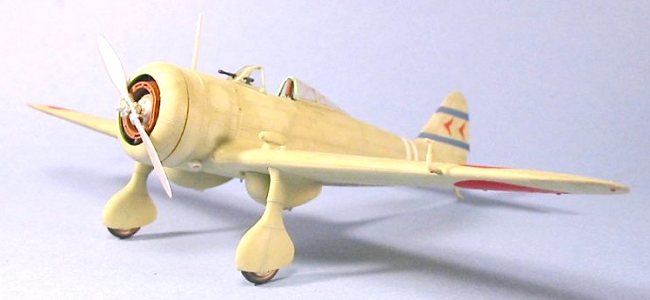
|
KIT # |
9433 'Manchuoko Air Force' |
|
PRICE: |
$23.98 MSRP |
|
DECALS: |
See review |
|
REVIEWER: |
|
|
NOTES: |
ex-Mania kit |

|
HISTORY |
Most fighter pilots prior to 1936 were technological conservatives who valued high-g close-in maneuverability in their biplane fighters more than they did the speed and armament increase possible with the all-metal monoplane. Perhaps no fighter pilots in the world were more conservative in this area than those of the Japanese Army Air Force, who were taught to compare themselves with the ancient Kendo masters, and to use the maneuverability of their aircraft in the same way that the Kendo master wielded his Shinai. Thus, when Koku Hombu - the Air H.Q. of the Imperial Army - issued their requirements for an "advanced fighter" in 1935, the primary goal was to graft the most desirable characteristics of the biplane onto a monoplane. The IJN had previously issued a similar requirement, which resulted in the 9-Shi fighter, known to the IJN as the A5M, and to history as the "Claude" fighter; Mitsubishi entered a modified A5M type, known as the Ki.33, in the competition. But for the JAAF, even this outstandingly-maneuverable monoplane was not maneuverable enough.
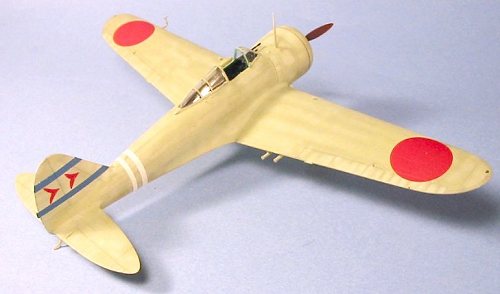 Chief Designer Tei
Koyama of Nakajima created a design that was even more exacting in terms of
weight control than what Jiro Horikoshi at Mitsubishi had achieved with the A5M,
representing the smallest possible airframe that could be designed around the
Nakajima Kotobuki-II Kai, a license-built version of the Bristol Jupiter. The
prototype, designated the Ki.27, first flew on October 15, 1936. When flown in
competition with the Mitsubishi Ki.33 and the Kawasaki Ki.28, the Ki.27
displayed noteworthy superiority as regarded maneuverability. At a weight of
only 2,866 lb., it had a wing loading of 14.33 lb/square foot, it had a clear
edge in close-in high-g combat maneuvering over its competitors. The new
warplane retained all the agility of the Ki.10 it was intended to replace, yet
offered major advances in speed and climb performance.
Chief Designer Tei
Koyama of Nakajima created a design that was even more exacting in terms of
weight control than what Jiro Horikoshi at Mitsubishi had achieved with the A5M,
representing the smallest possible airframe that could be designed around the
Nakajima Kotobuki-II Kai, a license-built version of the Bristol Jupiter. The
prototype, designated the Ki.27, first flew on October 15, 1936. When flown in
competition with the Mitsubishi Ki.33 and the Kawasaki Ki.28, the Ki.27
displayed noteworthy superiority as regarded maneuverability. At a weight of
only 2,866 lb., it had a wing loading of 14.33 lb/square foot, it had a clear
edge in close-in high-g combat maneuvering over its competitors. The new
warplane retained all the agility of the Ki.10 it was intended to replace, yet
offered major advances in speed and climb performance.
A trio of pre-production Ki-27s were assigned to the 1st Chutai of the 2nd Hiko-Datai in northern China in March, 1938. On April 10, 1938, the well-known JAAF ace Captain Tateo Kato, 1st Chutai CO, claimed the destruction of three Chinese-flown I-152s on his first mission. On April 15, the trio - accompanied by 12 Ki.10s - fought a pitched battle with 30 I-152s over Shansi, with Japanese claims of 24 out of 30. After this, the Chinese fighters were pulled back out of range of their new Japanese opponents. Despite the fact that the range and firepower of the Ki.27 even at the outset of its combat career was shown to be below that of the international standard, Koku Hombu made no move to try and improve the Ki.27, which was in fact an airframe that was so specialized it had no growth potential. Lacking range to escort bombers, the Ki.27 did not again see combat for a number of months. On April 20, 1939, the Ki.27 suffered its first combat losses in combat against Soviet-flown I-152s over Nanking. A month later, the Nomonhan "incident" - a three month war between the Imperial Japanese Army and the Soviet Union - began.
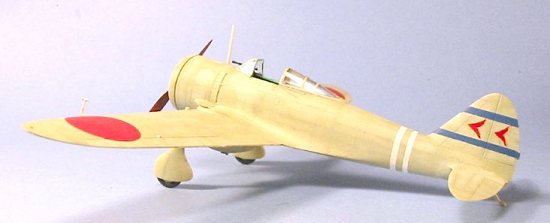 Within two weeks of
Mongolian cavalry crossing into Manchuria on May 11, 1939, fighting escalated to
aerial combat. On May 22, six patrolling ki.27s encountered six I-16s and shot
down three. On May 28, 60 I-16s and I-152s were intercepted by 18 Ki-27s, who
claimed 51 of the Soviet fighters without loss. On June 22, 1939, the 24th
Sentai claimed 54 of 60 I-16s, against a loss of 4 Ki.27s. These claims
were due to the vast difference between the highly-trained Japanese pilots and
their haphazardly-trained Soviet opponents. Throughout the Nomonhan Incident,
JAAF fighters consistently maintained a margin of aerial superiority.
Within two weeks of
Mongolian cavalry crossing into Manchuria on May 11, 1939, fighting escalated to
aerial combat. On May 22, six patrolling ki.27s encountered six I-16s and shot
down three. On May 28, 60 I-16s and I-152s were intercepted by 18 Ki-27s, who
claimed 51 of the Soviet fighters without loss. On June 22, 1939, the 24th
Sentai claimed 54 of 60 I-16s, against a loss of 4 Ki.27s. These claims
were due to the vast difference between the highly-trained Japanese pilots and
their haphazardly-trained Soviet opponents. Throughout the Nomonhan Incident,
JAAF fighters consistently maintained a margin of aerial superiority.
Shortcomings in the Ki.27 revealed in the Nomonhan incident were not corrected, since they resulted in adverse effects on performance of the fighter. In September, 1940, Nakajima was ordered to phase out production of the Ki.27 in favor of its successor, the Ki.43. Production was continued at the Mansyu plant in Harbin, Manchuria, until July 1942.
Outside of two Sentais equipped with the Ki.43-I-Ko and one independent Chutai equipped with the pre-production Ki.44, the JAAF entered the Pacific War still equipped with the Ki.27 as its major fighter. The extreme maneuverability of the fighter gave British pilots over Malaya fits, but the pilots of the American Volunteer Group, fighting over Rangoon, discovered that one good burst of their two .50 caliber machine guns was sufficient to explode the completely-unprotected Ki.27. Diving on the Japanese fighters, the AVG's P-40s could attack and dive away in the knowledge that the lightweight Ki.27 could not keep up with them. The 77th Sentai formed two-thirds of the Japanese fighters the Flying Tigers fought over Burma in the first months of 1942; to this day, one risks complete ostracism if they inform a veteran of the AVG that they did not in fact fight "Claudes" and "Zeros" over Rangoon, but rather "Nates" and "Oscars." By the end of 1942, the Ki.27 only equipped units assigned to defense of the Home Islands.
|
THE KIT |
Once upon a time, only
30 years ago, the world standard of detailed plastic model airplane kits was
Monogram. Hasegawa and Tamiya were also-rans who produced poorly-designed kits
whose primary value was that no one else was doing them;
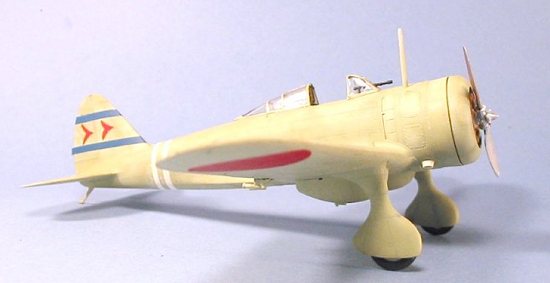 the majority of Tamiya kits
were in 1/50 scale, and were equipped with electric motors (that generally
didn't work), which precluded much interior detail. And then, in late 1970 and
early 1971, model kits from a new company began to appear. The company's name
was "Mania," and the word was that Japanese modelers who wanted good kits had
started the company. The first releases were in 1/72 scale, and the first of
these was the Ki.27. It had detail! One didn't have to scratch-build bits and
pieces in the cockpit to have some detail. This was followed by a Nakajima B5N2
Kate. In 1974, Mania announced they were going to release 1/48 kits. The first
was again the Ki.27, and it was a revelation: all the panel lines and the rivet
detail was engraved. The parts fit so much better than parts had fit on any
other kits that it was said all one had to do was assemble it. There was detail
in the cockpit! The kit cost $10, a stunning figure then in the days of $2.00
Monogram 1/48 kits. But, when you saw it, it lived up to the hype.
the majority of Tamiya kits
were in 1/50 scale, and were equipped with electric motors (that generally
didn't work), which precluded much interior detail. And then, in late 1970 and
early 1971, model kits from a new company began to appear. The company's name
was "Mania," and the word was that Japanese modelers who wanted good kits had
started the company. The first releases were in 1/72 scale, and the first of
these was the Ki.27. It had detail! One didn't have to scratch-build bits and
pieces in the cockpit to have some detail. This was followed by a Nakajima B5N2
Kate. In 1974, Mania announced they were going to release 1/48 kits. The first
was again the Ki.27, and it was a revelation: all the panel lines and the rivet
detail was engraved. The parts fit so much better than parts had fit on any
other kits that it was said all one had to do was assemble it. There was detail
in the cockpit! The kit cost $10, a stunning figure then in the days of $2.00
Monogram 1/48 kits. But, when you saw it, it lived up to the hype.
In 1975, Mania went out of business, not being capitalized sufficiently to support production and distribution of these kits at an economic level. The company was bought out by Hasegawa, and all of the kit designers were hired on. Within a matter of years, Hasegawa kits were transformed - though many still had raised-line detail, they had detailed cockpits, and good production design.
The Mania kit of the Nakajima Ki.27 was the first of the "Wunderkits," the kit that set the standard that exists today. Interestingly enough, it was so good that it continues to go in and out of production at Hasegawa, and a completed kit built out of the box can sit next to the brand-new Hasegawa Ki.43 and Ki.84 kits, without looking bad in comparison.
Last summer, I picked up one of these at a show for $5, and decided to find out if the first Wunderkit lived up to my 20-year old memories of it.
|
CONSTRUCTION |
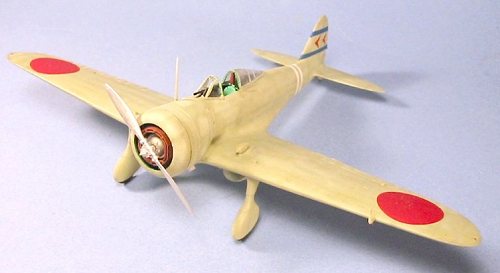 Assembling the kit is
straightforward and begins with the cockpit. Compared with any contemporary kit
of a Japanese airplane by Hasegawa, the cockpit is spartan, with much of the
detail that today would be separate pieces molded into the fuselage sides.
However, the cockpit was spartan, and the fact that it has a small opening means
not that much can be seen when assembled. Painting the interior with some
pre-shading and a later wash, combined with some dry-brushing of Model Master
Metalizer Aluminum, gave enough detail. I added seatbelts made from lead foil
taken from a wine bottle.
Assembling the kit is
straightforward and begins with the cockpit. Compared with any contemporary kit
of a Japanese airplane by Hasegawa, the cockpit is spartan, with much of the
detail that today would be separate pieces molded into the fuselage sides.
However, the cockpit was spartan, and the fact that it has a small opening means
not that much can be seen when assembled. Painting the interior with some
pre-shading and a later wash, combined with some dry-brushing of Model Master
Metalizer Aluminum, gave enough detail. I added seatbelts made from lead foil
taken from a wine bottle.
The rest of the kit goes together very easily. It does not fit as well as remembered, in comparison with a modern kit, but with a bit of test-fitting and re-shaping, it went together with only some Mr. Surfacer 500 needed on some of the joints. None of the really nice engraved surface detail was lost.
The canopy is thick, and there is no aftermarket replacement. I vacuformed a canopy with my trusty Mattel, but it really wasn't that good. I decided that I would cut off the sliding canopy portion, and assemble it without that - which is the way most Ki.27s were operated by their pilots, who were more used to open cockpits.
|
CAMOUFLAGE & MARKINGS |
Painting:
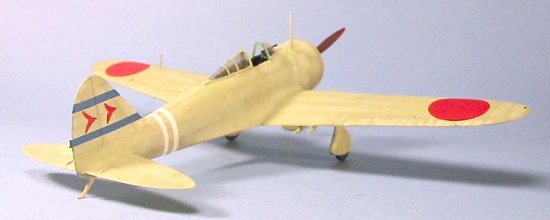 I pre-shaded the
model, then applied Gunze-Sangyo "JAAF Grey." I then added some white, and
"faded" the paint overall to fit with the tropic conditions an airplane from
77th Sentai would have operated in while flying from Bangkok against the AVG in
Rangoon in early 1942. I Futured the model and was ready for decals.
I pre-shaded the
model, then applied Gunze-Sangyo "JAAF Grey." I then added some white, and
"faded" the paint overall to fit with the tropic conditions an airplane from
77th Sentai would have operated in while flying from Bangkok against the AVG in
Rangoon in early 1942. I Futured the model and was ready for decals.
Decals:
The kit I had bought did not have useable decals. I used Honomarus from the decal dungeon, then made insignia for the 1st Chutai of the 77th Sentai, using blue and red decal sheets, and cutting out the stylized "Seagull" insignia of this unit.
Final Finish:
I finished the model with several coats of thinned Testor's Dullcote, after applying exhaust stains with Tamiya "Smoke".
|
CONCLUSIONS |
This 30-year old kit still stands up. It is not that difficult to assemble, and looks good next to more recent kits of Japanese airplanes. The Ki.27 is a historically-important design, fully deserving of display in any comprehensive collection of Japanese fighter aircraft of the Pacific War.
January 2003
Kit courtesy of my wallet.
If you would like your product reviewed fairly and fairly quickly, please contact the editor or see other details in the Note to Contributors.
Back to the Reviews Index Page